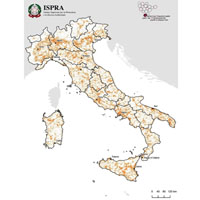Land degradation assessment for sustainable soil management

Accepted: 10 November 2020
HTML: 95
All claims expressed in this article are solely those of the authors and do not necessarily represent those of their affiliated organizations, or those of the publisher, the editors and the reviewers. Any product that may be evaluated in this article or claim that may be made by its manufacturer is not guaranteed or endorsed by the publisher.
Desertification is a complex phenomenon defined as the extreme degree of land degradation induced by human activities and climatic conditions. Climate change is accelerating and widening these areas. Previews analysis and studies assessed the vulnerability to desertification in Italy at national and regional level through a methodological approach based on integrating climate, soil, vegetation, and socio-economic data (ESA). The studies carried out by ISPRA aim to provide an update of the of land degradation assessment in Italy, based on Trends.Earth methodology and of the three UN-SDGs sub-indicators on Target 15.3.1 (land use/land cover, land productivity and soil organic carbon above and below ground status and trends), together with additional dimensions of land degradation considered crucial for national land characters. Final assessment of the percentage of degraded land is around 36% of national area. This exercise demonstrates the importance to consider a larger number of data and include information on other factors, such as climate, physical, chemical data. This integrated approach to the assessment of land degradation will allow to describe also of the loss of related ecosystem services.
Highlights
- Assessment and mapping of land degradation in Italy, toward an improvement of SDG Target 15.3 indicator.
- Trends.Earth methodology integrated with additional data and information, in order to map ecosystem conditions and related ecosystem services provision.
- Focus on land cover change as Italy main degradation factor.
- Analysis with disaggregated results is provided for a deeper understanding of the specific contribution of the sub-indicators at the local level.
- Improving sustainable land management by integrating land degradation prevention.
How to Cite
PAGEPress has chosen to apply the Creative Commons Attribution NonCommercial 4.0 International License (CC BY-NC 4.0) to all manuscripts to be published.

 https://doi.org/10.4081/ija.2020.1770
https://doi.org/10.4081/ija.2020.1770







